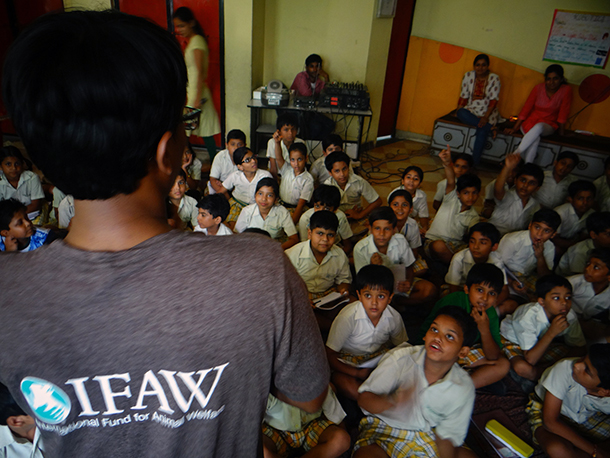On World Elephant Day in India, a “thumbs-up” for the elephants
By:
Sheren Shrestha
Manager- Animal Action Education, Awareness for Conservation
New Delhi, August 12 2014: In the sweltering humid heat of Delhi, Dr Mayukh Chatterjee, Achintya Tripathi and I were back in school. Figuratively speaking that is…
We were at the Bharat National Public School in Ram Vihar to talk to their students, as well as those in their sister school about India’s endangered animals.
It was August 12, the World Elephant Day!
We were excited to talk to children about India’s national heritage animal. The coordinator, Richa Arora, however wanted us to talk to the students about all wildlife. “We are getting the children to work on projects on endangered animals and we would want them to learn not just about elephants but other wildlife too,” said Richa, curriculum coordinator for these schools, who clearly knew what her students needed.
So we did.
We carried out three sessions, lasting around five hours in total, reaching out directly to over 250 students and around 10 teachers of these two schools.
We showcased selected pictures of varied wildlife of India – elephant, rhino, tiger, clouded leopard, great hornbill, Tibetan antelope, whale shark and many more. With each picture, we shared stories on these animals, asking them questions and their views, trying to stimulate their minds towards what India’s natural heritage faced.
Having trouble seeing the slideshow? Click here.
We told them how animals were being killed for their skin, horn, and other body parts.
We told them how their homes were being destroyed.
We screened the ‘Elephants, Never Forget’ AAE documentary, and had more interaction with them about elephants.
The kids had so much to say and ask; not a minute passed without some hands or another in the air.
When you’re dealing with children, you have to be prepared for the most difficult questions.
We had a challenging time explaining to them how a person bottle-feeding an elephant was not trying to raise the elephant to kill it for its tusk eventually; why an elephant has no bones in its trunk; why it was ok to punish people who did bad to animals; why the best way to deal with snakes was not to do anything at all, why we celebrate World Elephant Day and many more.
At the end of the session, we asked the kids if it was a good thing to kill animals?
‘No Sir!’ came the reply in a melodic unison.
Even at this age, these children know what is good and what not. And with teachers like Richa honing them, it will be a shocker if many of them do not grow up to be conscientious individuals looking out for the society even as they look out for themselves and their families and friends.
Before we closed, we asked them if they had heard the mythological story of Eklavya. One boy promptly got up and said:
“He was a very good archer and a devout student. His teacher asks for his thumb to fulfil his promise to another student, Arjuna (of the Pandavas in Mahabharata), to make the latter the best archer in the world. Without thinking twice, Eklavya cut off his thumb and presented it to his teacher.”
So we asked for their thumb!
A thumbs-up rather, indicating a promise to do what they can to save the elephants and other wildlife.










